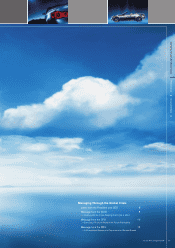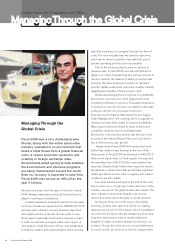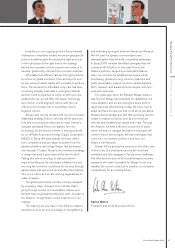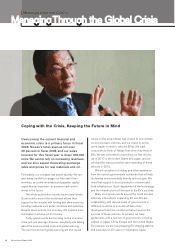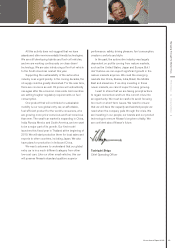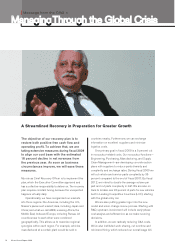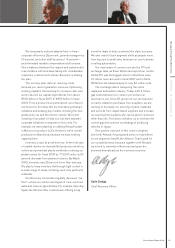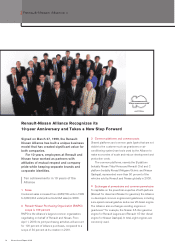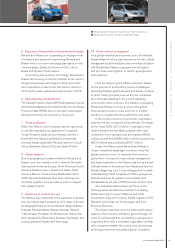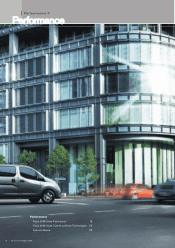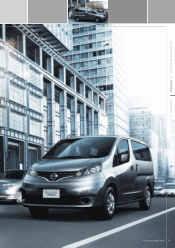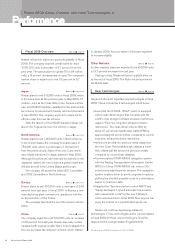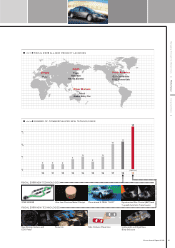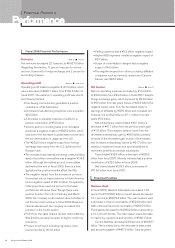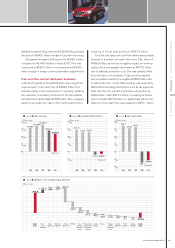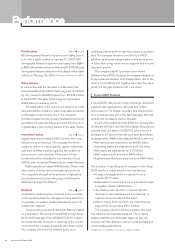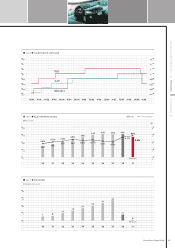Nissan 2009 Annual Report Download - page 17
Download and view the complete annual report
Please find page 17 of the 2009 Nissan annual report below. You can navigate through the pages in the report by either clicking on the pages listed below, or by using the keyword search tool below to find specific information within the annual report.
5 Expansion of the portfolio of advanced technologies
Renault and Nissan are cooperating on strategic fields
of research and advanced engineering. Renault and
Nissan have a common technology plan based on four
common pillars: Safety, Environment-CO2, Life-on-
Board and Dynamic Performance.
Concerning zero-emission technology, Renault and
Nissan are focusing on electric vehicles: so far, around
30 agreements have been signed with governments
and corporations to launch the first electric vehicle in
2010 and to mass market electrical vehicles in 2012.
6 Manufacturing standardization
The Renault ProductionSystem(RPS),the standard used by
all the Renault plants, borrowedextensively from the Nissan
Production Way (NPW). Since it has been implemented,
Renault productivity has improved by 15 percent.
7 Cross production
Within the Alliance, each company has the opportunity
to use the manufacturing capacities of its partner.
Today, Renault’s plants produce Nissan vehicles in
Korea (Almera Classic) and Brazil (Livina series),
whereas Nissan assembles Renault vehicles in South
Africa (Sandero), Mexico (Clio) and Spain (Trafic).
8 Global footprint
Due to geographical complementarities, Renault and
Nissan cover key markets on all continents. Renault’s
historical territories are Europe, North Africa and South
America; Nissan’s major markets are Japan, North
America, Mexico, China and the Middle East. Since
2005, Renault and Nissan have been entering new
territories together, such as India, in order to expand
their global footprint.
9 Expansion of product line-ups
The Alliance has contributed to the expansion of product
line-ups. Nissan has increased its LCV range in Europe
by badging Renault products: Renault Kangoo/Nissan
Kubistar, Renault Master/Nissan Interstar, Renault
Trafic/Nissan Primastar. On Renault side, Koleos has
been designed by Renault but developed by Nissan and
is using advanced Nissan 4x4 technology.
10 Cross-cultural management
As a global industrial and economic actor, the Renault-
Nissan Alliance built a unique experience in multi-cultural
management at all levels. Each year, more than 30 teams
with Renault and Nissan employees from all regions
and functions work together to identify synergies and
best practices.
From the beginning, the Alliance has been based
on the premise of trust and the pursuit of strategies
aimed at profitable growth. Renault and Nissan continue
to honor these principles, even as the two companies
are continually adapting to the current operating
environment, which is severe. The Alliance is equipping
Renault and Nissan not only to survive the global
financial and economic crisis, but to be in a better
position to compete effectively after this crisis ends.
In the current economic environment, cooperation
between the two companies will accelerate. The target
set for fiscal 2009 is €1.5 billion in synergies evenly
divided between the two Alliance partners with major
contribution from manufacturing and logistics (€363
million), powertrains (€289 million), vehicle engineering
(€279 million) and purchasing (€157 million).
Today, the Alliance gives Renault and Nissan a
unique competitive advantage in a sector hit by the
global economic crisis. To maximize the know-how
gained from 10 years of cross-cultural management
and shared experience, the Alliance has set up a small
dedicated team of six persons from Nissan and five from
Renault. Beginning June 1, they will apply their in-depth
understanding of both companies to foster synergies at
all levels and push for greater commonization and
standardization, not just in 2009 but well into the future.
This dedicated Alliance team will focus on the
following areas identified as priorities: Purchasing,
Global Sourcing, Common Platforms and Parts,
Powertrains, Support Functions, Global Logistics, IS/IT,
Research and Advanced Technologies, and Zero-
Emission Business.
The Alliance has been a tool for better performance,
based on the trust and confidence gained through 10
years of working together. Accelerating synergies and
supporting them with a dedicated organization will help
both companies weather the current crisis and emerge
as stronger and more competitive global companies.
Nissan Annual Report 2009 15
Managing Through the Global Crisis Performance Corporate Data
Renault Sandero: Produced in Nissan Rosslyn Plant (South Africa)
Nissan Livina: Produced in Renault Curitiba Plant (Brazil)
21
1
2


